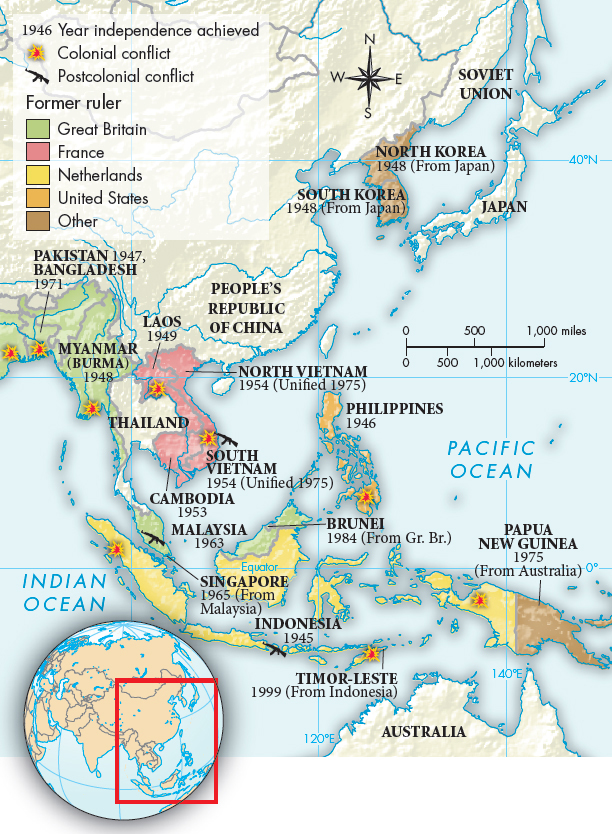Understanding World Societies:
Printed Page 967
Chapter Chronology
The Communist Victory in China

MAP 31.4Decolonization in AsiaAfter the Second World War, countries colonized by Britain, France, the Netherlands, and the United States gained their independence. In cases such as Vietnam and Indonesia, independence came through armed struggles against colonizers who were reluctant to leave.
When Japan surrendered to the Allies in August 1945, Communists and Nationalists both rushed to seize evacuated territory. Communists and Nationalists had fought each other before the Second World War, but had put aside their struggle to resist Japanese invasion. With the war over, the Nationalists and Communists resumed their conflict. By 1948 the Nationalist forces disintegrated before the better-led, more determined Communists. The following year Nationalist leader Jiang Jieshi and 2 million mainland Chinese fled to Taiwan, and in October 1949 Mao Zedong proclaimed the People’s Republic of China (Map 31.4).
Communism triumphed in China for many reasons. Mao Zedong and the Communists had avoided pitched battles and concentrated on winning peasant support and forming a broad anti-Japanese coalition. By reducing rents, promising land redistribution, enticing intellectuals, and spreading propaganda, they emerged in peasant eyes as the true patriots, the genuine nationalists.
Between 1949 and 1954 the Communists consolidated their rule. They seized the vast landholdings of a minority of landlords and rich peasants and distributed the land to 300 million poor peasants. Meanwhile, as Mao admitted in 1957, mass arrests led to eight hundred thousand “class enemies” being summarily executed; the true figure is probably much higher. Millions more were deported to forced-labor camps.
Mao and the party looked to the Soviet Union for inspiration in the early 1950s. China adopted collective agriculture and Soviet-style five-year plans to promote rapid industrialization. Russian specialists built many Chinese factories, and the Soviets provided considerable economic aid. In the cultural and intellectual realms, too, the Chinese followed the Soviet example. Basic civil and political rights were abolished. Temples and churches were closed. They enthusiastically promoted Soviet Marxist ideas concerning women and the family. Full equality, work outside the home, and state-supported child care became primary goals.
In 1958 China broke from the Marxist-Leninist course of development and began to go its own way. Mao proclaimed a Great Leap Forward in which industrial growth would be based on small-scale backyard workshops and steel mills run by peasants living in gigantic self-contained communes. The intended great leap produced an economic disaster, as land in the countryside went untilled when peasants turned to industrial production. As many as 30 million people died in famines that swept the country in 1960–1961. When Soviet premier Nikita Khrushchev criticized Chinese policy in 1960, Mao condemned him and his Russian colleagues as detestable “modern revisionists.” The Russians cut off economic and military aid, splitting the Communist world apart.
Mao lost influence in the party after the Great Leap Forward fiasco and the Sino-Soviet split, but in 1965 he staged a dramatic comeback, launching the Great Proletarian Cultural Revolution. He sought to purge the party and to recapture the revolutionary fervor of the guerrilla struggle (see “China’s Intellectual Revolution” in Chapter 29). The army and the nation’s young people responded enthusiastically, organizing themselves into radical cadres called Red Guards. Students denounced their teachers and practiced rebellion in the name of revolution. Mao’s thoughts, through his speeches and writings, were collected in the Little Red Book, which became scripture to the Red Guards.
The Red Guards sought to erase all traces of “feudal” and “bourgeois” culture and thought. Ancient monuments and countless works of art, antiques, and books were destroyed. Party officials, professors, and intellectuals were exiled to remote villages to purify themselves with heavy labor. Universities were shut down for years. Thousands of people died, many of them executed, and millions more were sent to rural forced-labor camps.
